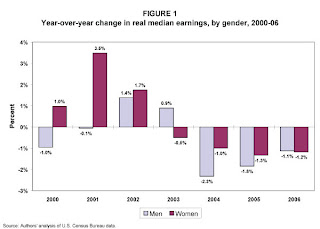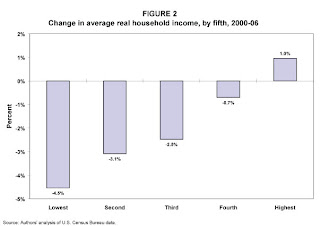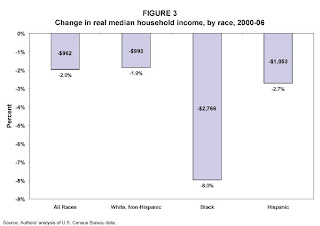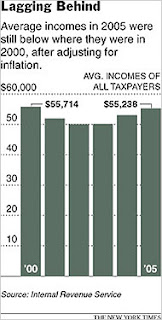AbstractThis brief compares metropolitan census tracts that improved with respect to poverty in the 1990s (poverty rate decreased by 5 percentage points or more) with those that worsened (poverty rate increased by 5 points or more); looking at the racial composition of both types and how the shares in both types varied in different locations within metropolitan areas and in different types of metropolitan areas nationally. It finds that while trends by these measures were considerably more favorable than in the 1980s, the 1990s still saw a mix of improving and worsening neighborhoods almost everywhere, warranting local action to address the challenges that both imply.
Thursday, August 30, 2007
Now it's the Urban Institute's Turn
Tuesday, August 28, 2007
From the CBPP
STATEMENT BY ROBERT GREENSTEIN,
EXECUTIVE DIRECTOR,
ON THE NEW CENSUS BUREAU DATA ON
POVERTY, INCOME, AND HEALTH INSURANCEThe new Census figures are disappointing for the fifth year of an economic recovery -- showing a significant decline in poverty for people over 65 but no significant decline in poverty for children or adults aged 18 to 64, and only a modest improvement in median income. In 2006, the poverty rate remained higher, and median income for non-elderly households remained $1,300 lower, than in 2001, when the last recession hit bottom. It is virtually unprecedented for poverty to be higher and the income of working-age households lower in the fifth year of a recovery than in the last year of the previous recession.
The new figures are the latest evidence that the economic growth of the past few years has been very uneven, with the gains concentrated among the highest-income Americans. Too many low- and middle-income families are not sharing in the gains. These figures are inconsistent with claims that the policies of recent years have produced an outstanding economic track record.
Number of Uninsured Children Climbs by 600,000
Perhaps of greatest concern, the number of Americans without health insurance increased 2.2 million in 2006, and the number of uninsured children jumped more than 600,000. The steady progress of recent years in reducing the number of uninsured children stalled in 2005 and began to reverse in 2006, in part because funding for the State Children’s Health Insurance Program (SCHIP) grew scarcer.
This is particularly noteworthy because the President has vowed to veto legislation that the House and Senate passed (in different versions) that would resume progress in this area and shrink the number of uninsured children by 3 to 4 million. In addition, on August 17, the Administration unveiled a controversial new policy that would force many states to cut back their SCHIP programs, forcing up to several hundred thousand more children into the ranks of the uninsured. Today’s sobering data on the rising number of uninsured children should prompt the President to rethink his positions on children’s health insurance.
This statement is posted to:
http://www.cbpp.org/8-28-07pov-stmt.htm
http://www.cbpp.org/8-28-07pov-stmt.pdf
Sunday, August 26, 2007
Afro-Latin Americans
GWB U2
Here's U2 themselves, in a video with some of the history behind the song:
Saturday, August 25, 2007
This is Interesting
From here (h/t Darksyde via Gadling):
Below is a list of the top fifty countries containing the largest percentage of people who identify as atheist, agnostic, or non-believer in God.
Country Total Pop.(2004) % Atheist/actual # Agnostic/Nonbeliever in God (minimum - maximum) 1 Sweden 8,986,000 46-85% 4,133,560-7,638,100 2 Vietnam 82,690,000 81% 66,978,900 3 Denmark 5,413,000 43-80% 2,327,590-4,330,400 4 Norway 4,575,000 31-72% 1,418,250-3,294,000 5 Japan 127,333,000 64-65% 81,493,120-82,766,450 6 Czech Republic 10,246,100 54-61% 5,328,940-6,250,121 7 Finland 5,215,000 28-60% 1,460,200-3,129,000 8 France 60,424,000 43-54% 25,982,320-32,628,960 9 South Korea 48,598,000 30%-52% 14,579,400-25,270,960 10 Estonia 1,342,000 49% 657,580 11 Germany 82,425,000 41-49% 33,794,250-40,388,250 12 Russia 143,782,000 24-48% 34,507,680-69,015,360 13 Hungary 10,032,000 32-46% 3,210,240-4,614,720 14 Netherlands 16,318,000 39-44% 6,364,020-7,179,920 15 Britain 60,271,000 31-44% 18,684,010-26,519,240 16 Belgium 10,348,000 42-43% 4,346,160-4,449,640 17 Bulgaria 7,518,000 34-40% 2,556,120-3,007,200 18 Slovenia 2,011,000 35-38% 703,850-764,180 19 Israel 6,199,000 15-37% 929,850-2,293,630 20 Canada 32,508,000 19-30% 6,176,520-9,752,400 21 Latvia 2,306,000 20-29% 461,200-668,740 22 Slovakia 5,424,000 10-28% 542,400-1,518,720 23 Switzerland 7,451,000 17-27% 1,266,670-2,011,770 24 Austria 8,175,000 18-26% 1,471,500-2,125,500 25 Australia 19,913,000 24-25% 4,779,120-4,978,250 26 Taiwan 22,750,000 24% 5,460,000 27 Spain 40,281,000 15-24% 6,042,150-9,667,440 28 Iceland 294,000 16-23% 47,040-67,620 29 New Zealand 3,994,000 20-22% 798,800-878,680 30 Ukraine 47,732,000 20% 9,546,400 31 Belarus 10,311,000 17% 1,752,870 32 Greece 10,648,000 16% 1,703,680 33 North Korea 22,698,000 15% ( ? ) 3,404,700 34 Italy 58,057,000 6-15% 3,483,420-8,708,550 35 Armenia 2,991,000 14% 418,740 36 China 1,298,848,000 8-14% ( ? ) 103,907,840-181,838,720 37 Lithuania 3,608,000 13% 469,040 38 Singapore 4,354,000 13% 566,020 39 Uruguay 3,399,000 12% 407,880 40 Kazakhstan 15,144,000 11-12% 1,665,840-1,817,280 41 Estonia 1,342,000 11% 147,620 42 Mongolia 2,751,000 9% 247,590 43 Portugal 10,524,000 4-9% 420,960-947,160 44 United States 293,028,000 3-9% 8,790,840-26,822,520 45 Albania 3,545,000 8% 283,600 46 Argentina 39,145,000 4-8% 1,565,800-3,131,600 47 Kyrgyzstan 5,081,000 7% 355,670 48 Dominican Rep. 8,834,000 7% 618,380 49 Cuba 11,309,000 7% ( ? ) 791,630 50 Croatia 4,497,000 7%
In sum, countries marked by high rates of organic atheism are among the most societally healthy on earth, while societies characterized by non-existent rates of organic atheism are among the most destitute. Nations marked by high degrees of organic atheism tend to have among the lowest homicide rates, infant mortality rates, poverty rates, and illiteracy rates, and among the highest levels of wealth, life expectancy, educational attainment, and gender equality in the world. The only indicator of societal health mentioned above in which religious countries fared better than irreligious countries was suicide
Of course, it is essential to clearly state that I am in no way arguing that high levels of organic atheism cause societal health or that low levels of organic atheism cause societal ills such as poverty or illiteracy. If anything, the opposite argument should be made: societal health causes widespread atheism, and societal insecurity causes widespread belief in God . . . .
Friday, August 24, 2007
New Orleans
Two years after Hurricane Katrina, the city's prisons are overflowing and inmates have mysteriously died behind bars. Critics denounce a justice system in tatters.By Robin Templeton
Aug. 23, 2007 | "I never got paid," Dewitt Solomon tells me. Nine months before the levees broke in the wake of Hurricane Katrina, he had a minimum-wage job busing tables and washing dishes at Messina's, the popular New Orleans tourist restaurant. But instead of paying him directly, Messina's gave Solomon's paychecks to the Orleans Parish Criminal Sheriff's Office. Solomon, who was serving time in the Orleans Parish Prison -- the eighth-largest penal institution in the country and the largest correctional facility in Louisiana -- was enrolled in the sheriff's work-release program. The prison was supposed to give him his wages, minus the $500 a month it deducted for room and board, the day Solomon regained his freedom. Solomon says that the sheriff still owes him $1,500.
. . . . . . .New Orleans has the highest incarceration rate of any major U.S. city -- double the national rate. Louisiana also locks up more people in local jails than any state, in part because of state laws, unheard of in other parts of the country, that paralyze due process.
District attorneys have 60 days from the time of arrest to decide whether to press charges and typically use the full statutory time limit. From there, it takes an average of three months for detainees to get a court date. It can take up to three years to get to trial. According to a recent study by the Vera Institute of Justice, 40 percent of those entering the Orleans Parish Prison would qualify to be released on their own recognizance. Instead, the city opts to lock people up if they can't post bail, which is true of three-quarters of the jail's detainees.
While it was bad before the storm, "now the system is only working to pick people up," says Loyola Law School professor Bill Quigley. "It's a vacuum, sucking poor people in and keeping them in. Being arrested now equals being sent to prison."
A year after Katrina, the city's backlog of cases peaked at 6,000. Judge Arthur Hunter of the Orleans Criminal District Court declared that "it is a pathetic and shameful state of affairs the criminal justice system finds itself in" and said that he would mark the one-year anniversary of the storm by beginning to release poor defendants.
But just as Hunter was declaring a constitutional state of emergency last summer, New Orleans was hit by a devastating crime wave. With half its former population, the city's crime rate escalated back to pre-Katrina levels. By the time the city was gearing up for its second post-Katrina Mardi Gras celebration, the national media was pronouncing New Orleans the murder capital of the United States.
Under the headline "Dysfunction Fuels Cycle of Killing in New Orleans," the New York Times reported in February a "uniquely poisoned set of circumstances" fueling the violence, including the destruction of the city's only crime lab, friction between police and prosecutors, community distrust and fear of the police, uncooperative or vanished witnesses and "murderers' brutalized childhoods." The majority of victims and suspects have been young African-American men -- many of them teenagers -- caught up in a drug trade that was reinvigorated, reorganized and made more lethal amid turf wars in the aftermath of Hurricane Katrina.
The crime crisis is part and parcel of a wider social crisis. Two years after the storm, only one-third of the childcare centers and 45 percent of the public schools in Orleans Parish have reopened. Mental health services for residents suffering from depression, drug addiction and posttraumatic stress disorder are nonexistent. The city's Housing Authority has slated thousands of units of public housing for demolition, the majority of which were not damaged by the storm.
. . . . . . .Police have been making a record number of arrests, now averaging 1,400 a week. But as the crime problem persists, they don't seem to be getting the bad guys. According to recent exit interviews with detainees leaving the parish jail, conducted by the local criminal justice reform organization Safe Streets/Strong Communities, 80 percent of inmates were being held for nonviolent offenses, mostly on low-level drug and alcohol charges. "While the city is plagued by violent crime, residents who will never be charged with a crime spend weeks in jail," the Vera Institute recently reported, "and some serious offenders are released with no charges."
Ursula Price, Safe Streets' outreach and investigations coordinator, describes the case of a woman in the jail who had called 911 about a domestic-violence incident. "Instead of trying to help her," Price says, "the police ran her name and ended up arresting her on an outstanding traffic violation."
Wednesday, August 22, 2007
Stopping SCHIP in its Tracks, Cont.
Despite a decade of marketing efforts by governments and private foundations, nearly 30 percent of children who are eligible for the health insurance program and are not covered by private plans have yet to enroll, according to a new government study.
Late last week, the Bush administration published new standards intended to prevent states from expanding eligibility for the program to cover children from middle-class families. But a more fundamental debate over the program has been raging in Washington for months: how to find and enroll the 1.7 million low-income children who are already eligible but have not signed up.
That hard-to-reach population is the focus of a showdown over reauthorizing the 10-year-old program, the largest single extension of government-subsidized health insurance since the Great Society health initiatives of 1965.
The challenge of enrolling those already eligible demonstrates how difficult it will be for states to meet the new standards. The policy says that states can expand eligibility only if they have first enrolled 95 percent of those who now qualify. Few states have come close to doing that; the national enrollment rate in 2004-2005 was 72 percent, according to the study.
More here.
Update: For some wonkier SCHIP discussion and analysis, take a look here.Tuesday, August 21, 2007
Monday, August 20, 2007
The Evils of Health Care for Children
The Bush administration, continuing its fight to stop states from expanding the popular Children’s Health Insurance Program, has adopted new standards that would make it much more difficult for New York, California and others to extend coverage to children in middle-income families.
Administration officials outlined the new standards in a letter sent to state health officials on Friday evening, in the middle of a month-long Congressional recess. In interviews, they said the changes were aimed at returning the Children’s Health Insurance Program to its original focus on low-income children and to make sure the program did not become a substitute for private health coverage.
After learning of the new policy, some state officials said today that it could cripple their efforts to cover more children by imposing standards that could not be met.
Ann Clemency Kohler, deputy commissioner of human services in New Jersey, said: “We are horrified at the new federal policy. It will cause havoc with our program and could jeopardize coverage for thousands of children.”
Stan Rosenstein, the Medicaid director in California, said the federal policy was “highly restrictive, much more restrictive than what we want to do.”
. . . . . . . .
The Children’s Health Insurance Program has strong support from governors of both parties, including Republicans like Arnold Schwarzenegger of California, Tim Pawlenty of Minnesota and Sonny Perdue of Georgia. When the Senate passed a bill to expand the program this month, 18 Republican senators voted for it, in defiance of a veto threat from Mr. Bush.
In the letter sent to state health officials about 7:30 p.m. on Friday, Dennis G. Smith, the director of the federal Center for Medicaid and State Operations, set a high standard for states that want to raise eligibility for the child health program above 250 percent of the poverty level.
Before making such a change, Mr. Smith said, states must demonstrate that they have “enrolled at least 95 percent of children in the state below 200 percent of the federal poverty level” who are eligible for either Medicaid or the child health program.
Deborah S. Bachrach, a deputy commissioner in the New York State Health Department, said, “No state in the nation has a participation rate of 95 percent.”
And Cindy Mann, a research professor at the Health Policy Institute of Georgetown University, said, “No state would ever achieve that level of participation under the president’s budget proposals.”
The Congressional Budget Office has said that the president’s budget, which seeks $30 billion from 2008 to 2012, is not enough to pay for current levels of enrollment, much less to cover children who are eligible but not enrolled.
Sunday, August 19, 2007
"The 100-Year Struggle for Mine Safety"
It says a lot about this country that for more than 100 years, our nation’s coal miners have been forced to continually fight for workplace safety. But keeping up the fight to literally stay alive is essential because no matter how far we’ve advanced technologically, miners still must battle “irresponsible coal operators.”
. . . . .
Despite seismologists’ confirmation that the collapse was not caused by an earthquake, Murray insists that it was an act of God (which just happens to be legally untouchable) for the accident.But look at his record. As Forbes reports, the Galatia mine in southern Illinois, owned by Murray subsidiary American Coal Co., has received 869 violations so far this year, leading one mining expert to believe the company is “just going for the production and not going for the safety.”
Thursday, August 09, 2007
"Stuck and Suicidal in a Post-Katrina Trailer Park"
Go listen HERE."What's it like to live around here?" I asked.
"Well," he replied, "I'll be honest."
"Ain't a day goes by when I don't think about killing myself."
And so began my time in Scenic Trails, a FEMA trailer park deep in the Mississippi woods where 100 families have lived in near isolation for close to two years.
Though Szepek was the first resident to tell me he wanted to commit suicide, he certainly wasn't the last. The day I spoke with him, three other residents confided the same.
Friday, August 03, 2007
Yet Another Way
Holding a whole bunch of stuff constant, including several political variables, we found that if a black person killed a white person they were more likely to get executed. If a Hispanic killed a white person they were also more likely, but this probability wasn't quite as strong. There is more than a twofold greater risk that an African-American who killed a white will be executed than a white person who kills a nonwhite victim. A Hispanic is at least 1.4 times more likely to be executed if such an offender kills a white. Both findings are statistically significant. Also, the findings indicate that blacks who kill nonwhites are less likely to be executed than blacks who kill whites, which shows that the postsentencing capital-punishment process continues to place greater value on white lives.Here's the article the author is speaking about:
David Jacobs, Zhenchao Qian, Jason T. Carmichael, and Stephanie L. Kent,
"Who Survives on Death Row? An Individual and Contextual Analysis,"
American Sociological Review 72, Number 4 * August 2007




